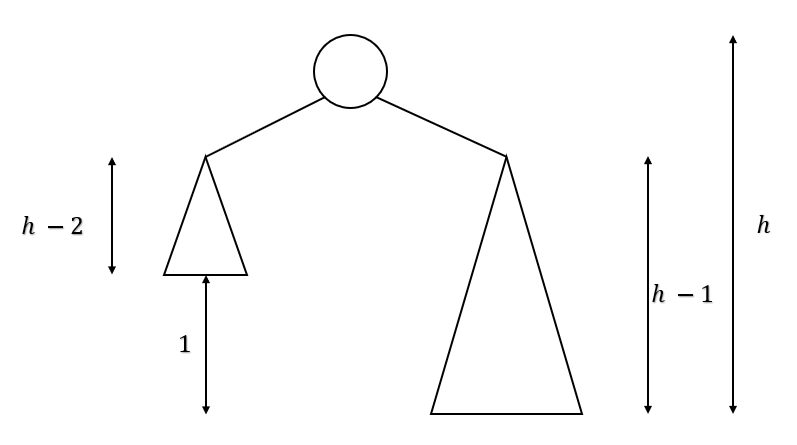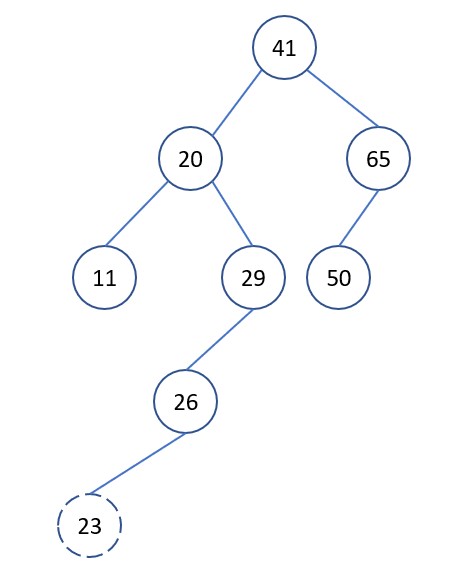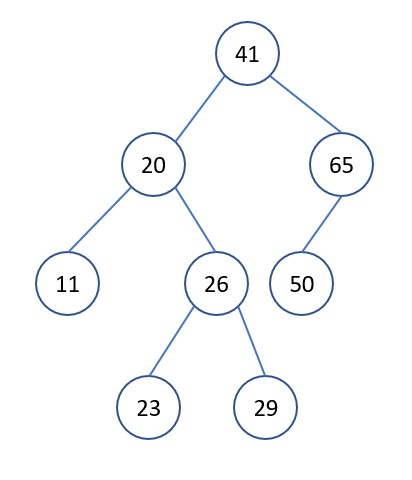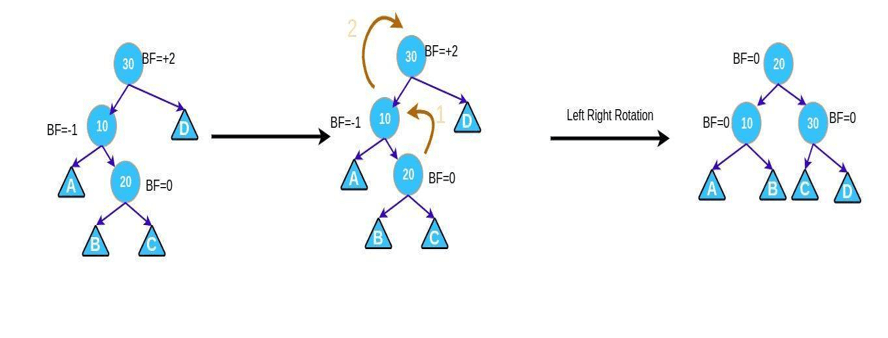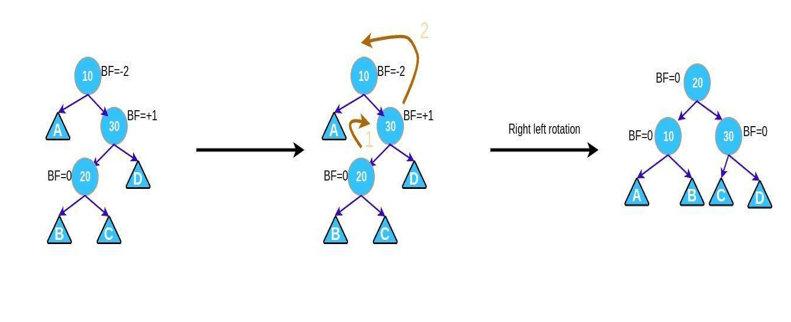In the previous post, I talked about the binary search tree. With efficiency in search, insert, delete,... binary search tree can be done in logrithmic time () in the average case. In this article, I will talk about AVL tree, which is a type of binary search tree, ensuring that in all cases, the time complexity of the above operations is the same .
1. AVL tree
An AVL tree is a balanced binary search tree in which the heights of the left and right subtrees differ by at most 1 . In the process of performing operations on the tree that make the tree unbalanced, we need to rebalance the tree to ensure the nature of the tree .
2. Tree height assessment
The height of the tree
= max{ left subtree height, right subtree height } + 1
The heights of the nodes are numbered as shown above.
With the property , the worst case of an AVL tree occurs when the right subtree is 1 unit taller than the left subtree for all nodes (or vice versa).
For is the smallest number of nodes in a tree of height .
With the diagram above, we have
và
2.1. First approach
The above expression reminds us of the fibonacci sequence, we have với is the fibonacci. We have , with , (golden ratio).
With (the number of nodes in the tree).
.
2.2. Second approach
Therefore, .
3. AVL tree operations
3.1. Node insertion, node deletion, search node
The above operations in an AVL tree are the same as in a binary search tree, with . The difference in node insertion and deletion is that after performing those operations, we need to do an extra step of tree balancing to ensure the integrity of the tree .
3.2. Tree balancing activities
The following example demonstrates the need for tree rebalancing
Suppose we have the following tree
We want to insert into the tree, perform the insertion as in a binary search tree. After inserting, we see the property violated. We need to rebalance the tree to get
3.2.1. Balance factor
In a binary tree, the balance factor is defined as follows:
= height of left subtree if height of right subtree of .
Thus, in the AVL tree, we have .
3.2.2. Tree balancing operations
When the BF of a certain node has a value that is not in the above set of values, then we need to re-balancing the tree. We have two basic types of balancing operations of AVL trees: right rotation and left rotation
3.3. Tree balancing in specific cases
3.3.1. Left left case
This case occurs when a node has BF = 2 and its left subtree has BF = 1. Then, we only need 1 right rotation at the node to be considered, then the tree is balanced.
3.3.2. Left right case
This case occurs when a node has BF = 2 and its left subtree has BF = -1. Then, we need to do the following 2 steps in turn
- Left rotation left subtree.
- Right rotation the node to be considered.
3.3.3. Right right case
This case occurs when a node has BF = -2 and its right subtree has BF = -1. Then, we only need 1 left rotation at the node to be considered, then the tree is balanced.
3.3.4. Right left case
This case occurs when a node has BF = -2 and its left subtree has BF = 1. Then, we need to do the following 2 steps in turn
- Right rotation right subtree.
- Left rotation the node to be considered.
4. Python code for tree balancing activities
# ---------------------------METHOD TO HELP BALANCE THE TREE---------------------------
# y x
# / \ Right Rotation / \
# x T3 - - - - - - - > T1 y
# / \ < - - - - - - - / \
# T1 T2 Left Rotation T2 T3
# ---------------------------BALANCE THE TREE IN PARTICULAR CASES---------------------------
# -----Left Left Case
# z y
# / \ / \
# y T4 Right Rotate (z) x z
# / \ - - - - - - - - -> / \ / \
# x T3 T1 T2 T3 T4
# / \
# T1 T2
# -----Left Right Case
# z z x
# / \ / \ / \
# y T4 Left Rotate (y) x T4 Right Rotate(z) y z
# / \ - - - - - - - - -> / \ - - - - - - - -> / \ / \
# T1 x y T3 T1 T2 T3 T4
# / \ / \
# T2 T3 T1 T2
# -----Right Right Case
# z y
# / \ / \
# T1 y Left Rotate(z) z x
# / \ - - - - - - - -> / \ / \
# T2 x T1 T2 T3 T4
# / \
# T3 T4
# -----Right Left Case
# z z x
# / \ / \ / \
# T1 y Right Rotate (y) T1 x Left Rotate(z) z y
# / \ - - - - - - - - -> / \ - - - - - - - -> / \ / \
# x T4 T2 y T1 T2 T3 T4
# / \ / \
# T2 T3 T3 T4
class AVLNode:
def __init__(self, val):
self.left = None
self.right = None
self.val = val
self.height = 1
class AVLTree:
def insert(self, root, key):
# perform bst
if not root:
return AVLNode(key)
if root.val < key:
root.right = self.insert(root.right, key)
if root.val > key:
root.left = self.insert(root.left, key)
# update the height of the ancestor node
root.height = 1 + max(self.get_height(root.left),
self.get_height(root.right))
# get balance factor
balance = self.get_balance(root)
# perform balance
# left left
if balance > 1 and key < root.left.val:
return self.right_rotate(root)
# right right
if balance < -1 and key > root.right.val:
return self.left_rotate(root)
# left right
if balance > 1 and key > root.left.val:
root.left = self.left_rotate(root.left)
return self.right_rotate(root)
# right left
if balance < -1 and key < root.left.val:
root.right = self.right_rotate(root.right)
return self.left_rotate(root)
return root
def left_rotate(self, x):
y = x.right
T2 = y.left
y.left = x
x.right = T2
x.height = 1 + max(self.get_height(x.left), self.get_height(x.right))
y.height = 1 + max(self.get_height(y.left), self.get_height(y.right))
return y
def right_rotate(self, y):
x = y.left
T2 = x.right
x.right = y
y.left = T2
x.height = 1 + max(self.get_height(x.left), self.get_height(x.right))
y.height = 1 + max(self.get_height(y.left), self.get_height(y.right))
return x
def get_height(self, root):
if not root:
return 0
return root.height
def get_balance(self, root):
if not root:
return 0
return self.get_height(root.left) - self.get_height(root.right)
def inorder(self, root):
if root is not None:
self.inorder(root.left)
print(root.val)
self.inorder(root.right)
avl_tree = AVLTree()
root = None
root = avl_tree.insert(root, 20)
root = avl_tree.insert(root, 10)
root = avl_tree.insert(root, 30)
root = avl_tree.insert(root, 40)
root = avl_tree.insert(root, 50)
root = avl_tree.insert(root, 5)
root = avl_tree.insert(root, 15)
root = avl_tree.insert(root, 25)
root = avl_tree.insert(root, 55)
avl_tree.inorder(root)
5. AVL sorting algorithm
Given an array of elements, the AVL sorting algorithm is done through the following steps
- Perform inserts elements into AVL tree. Each inserted operation costs time (as in a binary search tree). We need to insert elements, so the time complexity of the process will be .
- We perform inorder traversal (as in a binary search tree). This causes us to go through all the elements, so the time complexity of the process is .
Therefore, the total time complexity is . However, because of the extra makes this AVL sorting algorithm inefficient and less practical than the other sorting algorithms that I have listed.
6. Additional notes
Readers can find visualizations for AVL tree operations at USFCA website.


